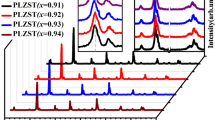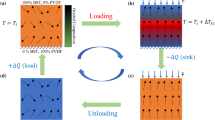Abstract
Ferroelectric materials have great potential use for solid-state refrigeration. However, their working temperature is restricted to Curie temperature; the working temperature can be increased by the new component of strain gradient-driven caloric effect or flexocaloric effect (FCE). The FCE relies on the inhomogeneous strain of the crystal lattice to induce polarization in centrosymmetric crystals (flexoelectricity). The strain gradient-induced polarization is defined by flexoelectric polarization coefficient and is utilized to estimate the FCE. As the FCE is a relatively new phenomenon, several ways can be used to calculate it. Different methods of flexocaloric quantification in ferroelectric materials (Pb(Mg1/3Nb2/3)O3 and Ba0.67Sr0.33TiO3) are discussed in the present work. The FCE can be obtained based on the measured properties and combination between the polarization and strain. This allows one to study the actual or net flexocaloric behavior in the material. It was found that the quantification of temperature change varies according to the method used for estimation. The experimental confirmation is required for validation of the proposed methods of estimation. Further, this work also discusses the possibility of other ways that are untouched by the research community. The analysis indicates a substantial untapped potential for solid-state refrigeration and warrants further research.







Similar content being viewed by others
Data Availability
The data that support the findings of this study are available within this article.
References
B. Wang, Y. Gu, S. Zhang, L.-Q. Chen. Flexoelectricity in solids: Progress, challenges, and perspectives. Prog. Mater. Sci. 106, 100570 (2019). https://doi.org/10.1016/j.pmatsci.2019.05.003.
L. Shu, W. Huang, S. R. Kwon, Z. Wang, F. Li, X. Wei, S. Zhang, M. Lanagan, X. Yao, X. Jiang. Converse flexoelectric coefficient f1212 in bulk Ba0.67Sr0.33TiO3. Appl. Phys. Lett. 104(23):232902 (2014). https://doi.org/10.1063/1.4882060.
A. Chauhan, S. Patel, A. Kumar, I. Ponomareva, R. Kumar, R. Vaish, Pyro-paraelectric effect in ferroelectric materials: A device perspective for transcending Curie limitation. Mater Today Commun 12, 146–151 (2017). https://doi.org/10.1016/j.mtcomm.2017.07.005
W. Huang, X. Yan, S. R. Kwon, S. Zhang, F.-G. Yuan, X. Jiang. Flexoelectric strain gradient detection using Ba0.64Sr0.36TiO3 for sensing. Appl Phys Lett 101(25):252903 (2012). https://doi.org/10.1063/1.4772803.
N. Mawassy, H. Reda, J.-F. Ganghoffer, V. A. Eremeyev, H. Lakiss. A variational approach of homogenization of piezoelectric composites towards piezoelectric and flexoelectric effective media. International Journal of Engineering Science 158:103410 (2021). https://doi.org/10.1016/j.ijengsci.2020.103410.
M. Malikan, V. A. Eremeyev. On the dynamics of a visco-piezo-flexoelectric nanobeam. Symmetry 12(4):643 (2020). https://doi.org/10.3390/sym12040643.
V. A. Eremeyev, J.-F. Ganghoffer, V. Konopińska-Zmysłowska, N. S. Uglov. Flexoelectricity and apparent piezoelectricity of a pantographic micro-bar. Int J. Eng. Sci. 149:103213 (2020). https://doi.org/10.1016/j.ijengsci.2020.103213.
A. Starkov, I. Starkov. Flexocaloric effect in thin plates of barium titanate and strontium titanate. Phys. Solid State 61(12), 2542–2546 (2014). https://doi.org/10.1134/S1063783419120539.
L.E. Cross, Flexoelectric effects: Charge separation in insulating solids subjected to elastic strain gradients. J. Mater. Sci. 41(1), 53–63 (2006). https://doi.org/10.1007/s10853-005-5916-6
Ma W, L. E. Cross. Strain-gradient-induced electric polarization in lead zirconate titanate ceramics. Appl. Phys. Lett. 82(19), 3293–3295. https://doi.org/10.1063/1.1570517.
S. Patel, A. Chauhan, J. Cuozzo, S. Lisenkov, I. Ponomareva, R. Vaish. Pyro-paraelectric and flexocaloric effects in barium strontium titanate: A first principles approach. Appl. Phys. Lett. 108(16), 162901 (2016). https://doi.org/10.1063/1.4947010.
A. Starkov, I. Starkov. Multicaloric effect in a solid: New aspects. J. Exp. Theor. Phys. 119(2):258–263 (2014). https://doi.org/10.1134/S1063776114070097.
A.S. Starkov, I. A. Starkov. Giant piezocaloric effect in PZT ceramic film. Ferroelectrics 483(1), 102–107 (2015). https://doi.org/10.1080/00150193.2015.1059147.
I.A. Starkov, A.S. Starkov, A generalized thermodynamic theory of the multicaloric effect in single-phase solids. Int. J. Solids. Struct. 100–101, 187–194 (2016). https://doi.org/10.1016/j.ijsolstr.2016.08.015
S. Patel, A. Chauhan, N. A. Madhar, B. Ilahi, R. Vaish. Flexoelectric induced caloric effect in truncated pyramid shaped Ba0.67Sr0.33TiO3 ferroelectric material. J. Electron Mater. 46(7):4166–4171 (2014). https://doi.org/10.1007/s11664-017-5362-7.
S. Patel, A. Chauhan, R. Vaish. Flexo/electro-caloric performance of BaTi0.87Sn0.13O3 ceramics. Appl. Phys. Lett. 117(9), 092904 (2020). https://doi.org/10.1063/5.0017687.
G. Bai, Z. Liu, Q. Xie, Y. Guo, W. Li, X. Yan. The flexoelectric effect associated size dependent pyroelectricity in solid dielectrics. AIP Adv. 5(9), 097117 (2015). https://doi.org/10.1063/1.4930595.
G. Bai, K. Qin, Q. Xie, X. Yan, C. Gao, Z. Liu. Size dependent flexocaloric effect of paraelectric Ba0.67Sr0.33TiO3 nanostructures. Mater. Lett. 186, 146–150 (2017). https://doi.org/10.1016/j.matlet.2016.10.001.
L. Luo, X. Jiang, Y. Zhang, K. Li. Electrocaloric effect and pyroelectric energy harvesting of (0.94-x)Na0.5Bi0.5TiO3–0.06BaTiO3-xSrTiO3 ceramics. J. Eur. Ceram. Soc. 37(8), 2803–2812 (2017). https://doi.org/10.1016/j.jeurceramsoc.2017.02.047.
Y. Liu, J. F. Scott, B. Dkhil. Direct and indirect measurements on electrocaloric effect: Recent developments and perspectives. Appl. Phys. Rev. 3(3), 031102 (2016). https://doi.org/10.1063/1.4958327.
M.M. Vopson, Theory of giant-caloric effects in multiferroic materials. J. Phys. D Appl. Phys. 46(34) (2013). https://doi.org/10.1088/0022-3727/46/34/345304
J. Narvaez, G. Catalan. Origin of the enhanced flexoelectricity of relaxor ferroelectrics. Appl. Phys. Lett. 104(16), 162903 (2014). https://doi.org/10.1063/1.4871686.
X. Jiang, W. Huang, S. Zhang. Flexoelectric nano-generator: Materials, structures and devices. Nano Energy 2(6), 1079–1092 (2013). https://doi.org/10.1016/j.nanoen.2013.09.001.
W. Ma, Flexoelectric charge separation and size dependent piezoelectricity in dielectric solids. Phys. Status Solidi. B 247(1), 213–218 (2010). https://doi.org/10.1002/pssb.200945394
G. Zhang, S. Jiang, Y. Zeng, Y. Zhang, Q. Zhang, Y. Yu. High pyroelectric properties of porous Ba0.67Sr0.33TiO3 for uncooled infrared detectors. J. Am. Ceram. Soc. 92(12), 3132–3134 (2009). https://doi.org/10.1111/j.1551-2916.2009.03355.x.
S. Jiang, P. Liu, X. Zhang, L. Zhang, Q. Li, J. Yao, Y. Zeng, Q. Wang, G. Zhang. Enhanced pyroelectric properties of porous Ba0.67Sr0.33TiO3 ceramics fabricated with carbon nanotubes. J. Alloys. Compd. 636, 93–96 (2015). https://doi.org/10.1016/j.jallcom.2015.02.153.
I.M. McKinley, F.Y. Lee, L. Pilon, A novel thermomechanical energy conversion cycle. Appl. Energy 126, 78–89 (2014). https://doi.org/10.1016/j.apenergy.2014.03.069
A. S. Mischenko, Q. Zhang, J. F. Scott, R. W. Whatmore, N. D. Mathur. Giant electrocaloric effect in thin-film PbZr0.95Ti0.05O3. Science 311(5765), 1270 (2016). https://doi.org/10.1126/science.1123811.
H. Khassaf Combined intrinsic caloric effects in ferroelectrics. PhD Dissertations, University of Connecticut (2017). https://opencommons.uconn.edu/dissertations/1382.
L. Shu, M. Wan, X. Jiang, F. Li, N. Zhou, W. Huang, T. Wang. Frequency dispersion of flexoelectricity in PMN-PT single crystal. AIP Adv. 7(1), 015010. https://doi.org/10.1063/1.4973684.
Acknowledgements
The author thanks Dr. Nikola Novak from the Jožef Stefan Institute, Slovenia, for proofreading the manuscript. The author also thanks Science and Engineering Research Board (SERB) for financial support in the frame of the Start-up Research Grant no. SRG/2020/000188.
Author information
Authors and Affiliations
Corresponding author
Ethics declarations
Conflict of interest
The authors declare that they have no known competing financial interests or personal relationships that could have appeared to influence the work reported in this paper.
Additional information
Publisher's Note
Springer Nature remains neutral with regard to jurisdictional claims in published maps and institutional affiliations.
Rights and permissions
About this article
Cite this article
Patel, S. Flexocaloric effect in ferroelectric materials: methods of indirect evaluation. Appl. Phys. A 127, 411 (2021). https://doi.org/10.1007/s00339-021-04585-8
Received:
Accepted:
Published:
DOI: https://doi.org/10.1007/s00339-021-04585-8




